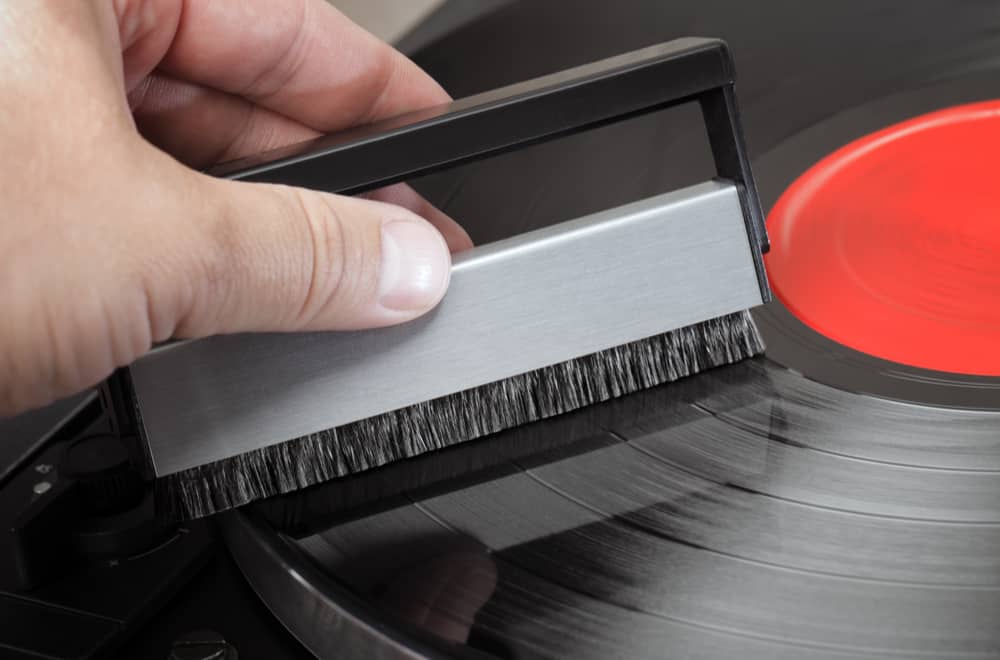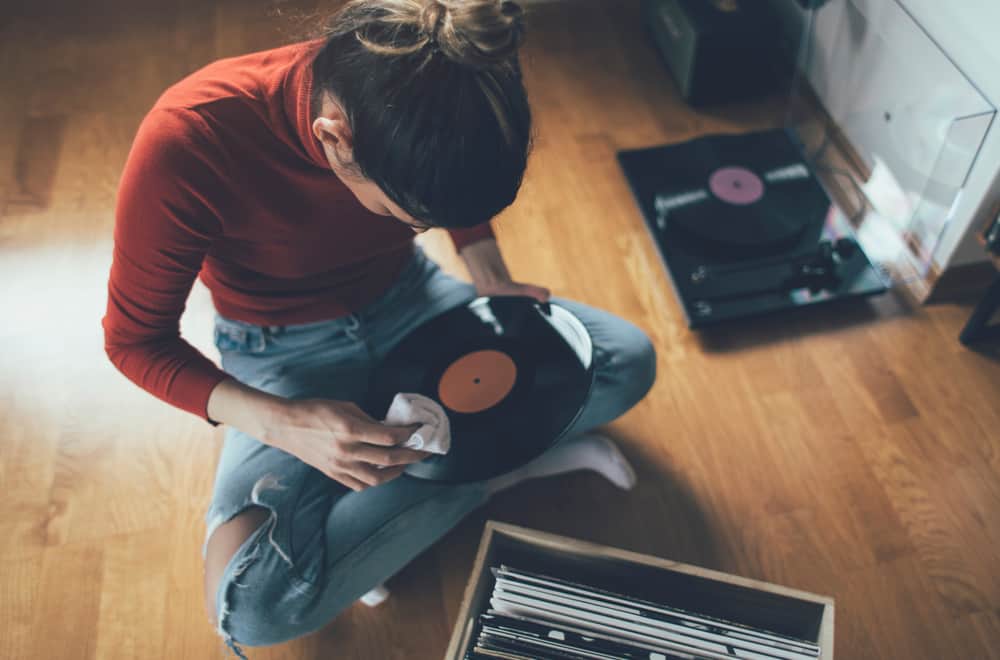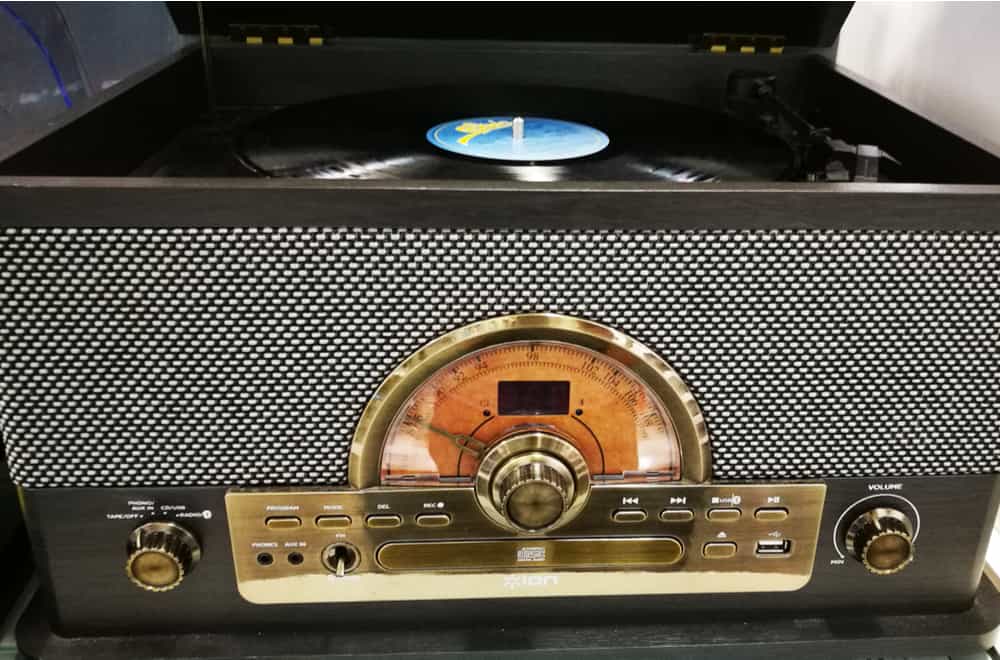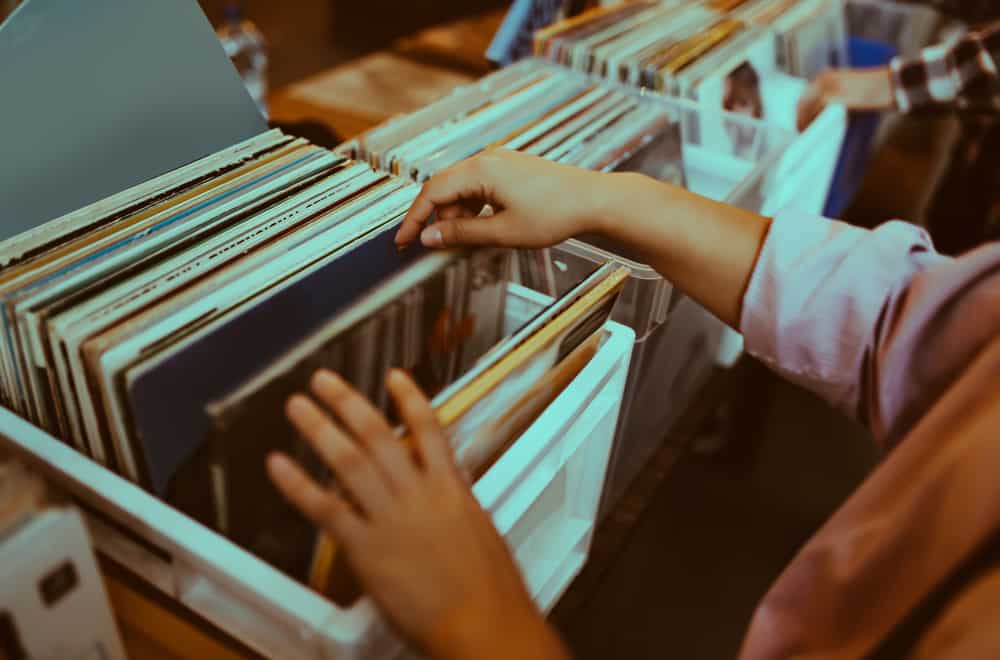Whether you’re trying to rescue a weathered vinyl record that you just got from your favorite pawn shop or just looking to keep your collection in top shape, learning how to clean vinyl records without damaging them is crucial.
A quick look online reveals dozens of methods, some of which are simply too harsh. Thus, let’s see how to clean your records the proper way.
Table of Contents
1. Use an Anti-Static Record Cleaning Brush
Cleaning your vinyl records with a record cleaning brush is one of the safest and easiest methods. You can use it on freshly pressed, and vintage records alike, and the investment is minimal. These brushes are easy to find in most music stores and rarely cost more than $20.
Once you’ve bought the cleaning tool, here’s what to do:
- Place the record you want to clean on the turntable and turn the turntable on.
- Place the brush on the turning record, holding it at a 90-degree angle. Don’t exert any pressure, as the anti-static bristles will attract the dirt and grime anyway. As the record is spinning, the bristles will be able to clean the record’s grooves.
- After two or three turns, lift the brush and spin it into its holster. This will cause the carbon fibers bristles to rub against the compartment, kicking off any lingering dust. Repeat the operation three-five times until the record is clean.
One thing to keep in mind when using a record cleaning brush is that the carbon fiber bristles can capture much more than dust and grime. For this reason, you should never touch the bristles with your fingers, as you’ll only manage to transfer your skin oils onto the record. If you can’t keep yourself from touching the bristles, put on a pair of clean latex gloves before beginning.
2. Clean Your Records with Record Cleaner
Wiping the records with a cleaning solution may be necessary if you’ve cleaned them with a brush but can still hear clicks and pops when playing them.
The method is similar to wiping your computer screen or smartphone with a screen cleaning solution. However, you should only use a vinyl record cleaning solution for this purpose, as other products could be too harsh.
Solution aside, you’ll also need a soft microfiber cloth – never use a cloth made of other materials because lint could end up in the record grooves and cause damage.
To clean the record, spray or pour the solution onto the microfiber cloth, not onto the record. Then, wipe the surface clean in a circular motion and without applying too much pressure. If you press too hard, the dust and gunk can sink deeper into the grooves and could become impossible to remove.
After a few spins, let the leftover solution dry before playing the vinyl record. It is not recommended to wipe the record dry because fiber residues could end up in the grooves.
3. Use a Record Bath System
Record baths offer another affordable way to clean vinyl records without damaging them. These devices can also take manual cleaning off of you, making them very practical for those moments when you want to clean your whole collection, although you’ll still have to spin each record manually.
A record bath typically consists of a plastic tub. To clean the records, you’ll have to fill the bath with distilled water or a cleaning solution, but you should only use the appropriate cleaner as instructed by the manufacturer – most baths use distilled water.
Simply fill the tub, place a record in it and spin it. Two rollers and a pair of brushes positioned inside the tub will wash off any dust and grime. After a few spins, you can wipe the records with a microfiber cloth soaked in a record cleaning solution, then let them air dry.
The only downside of this method is that you’ll have to empty the basin and refill it regularly to avoid cross-contamination. In most cases, you should be able to clean about 20-25 records per refill, but the only way to avoid cross-contamination completely is by changing the water after cleaning each record.
How to Clean Vinyl Records
Alternative Method: Wash Your Vinyl Records
All methods above imply the use of specific cleaning products, so what can you do if you’re trying to listen to your favorite vinyl but can’t enjoy it due to dust and grime? You could try cleaning it with products you most likely have in your home – although you should only use this method sporadically.
You will need
- Distilled or deionized water
- Dish soap
- Carbon fiber brush or another soft brush
- Microfiber cloth
- Latex gloves
1 – Prepare the cleaning liquid
Warm up the distilled or deionized water – don’t bring it to a boiling point; you’re aiming for lukewarm. Then, pour a small quantity of dish soap and stir to create lightly soapy water.
2 – Remove any loose particles
Use the carbon fiber brush (or another anti-static brush with soft bristles) to remove any dust and other loose particles from the record. The easiest way to do this is while the record is spinning on the turntable, as explained above.
3 – Clean the record
Once you’ve removed the loose particles, put on a pair of latex gloves and proceed to deep-cleaning the record. The latex gloves are essential to avoid transferring the oils on your skin to the record.
Simply wrap the microfiber cloth around your finger and dip it in the soapy water you’ve prepared earlier. Then, starting from the center of the record, wipe the entire surface in a circular motion. Don’t apply too much pressure, and keep an eye on the cloth. Clean it each time you notice dust and grime on it.
Repeat two three times, then use a dry part of the cloth to gently dab any excess moisture you may notice on the record.
4 – Rinse the record
The main downside of using soaping water is that dish soap will leave some residue behind. Thus, you’ll have to rinse the record with clean water after you’ve cleaned it. Only use distilled or deionized water for this purpose and a new microfiber cloth to remove all soap traces.
5 – Let it dry and enjoy
After cleaning and rinsing, all you have to do is to leave the record to dry completely before playing it. While you’re waiting, it could be a good idea to clean the turntable stylus too.
Can I Clean Vinyl Records with a Vacuum Cleaner?
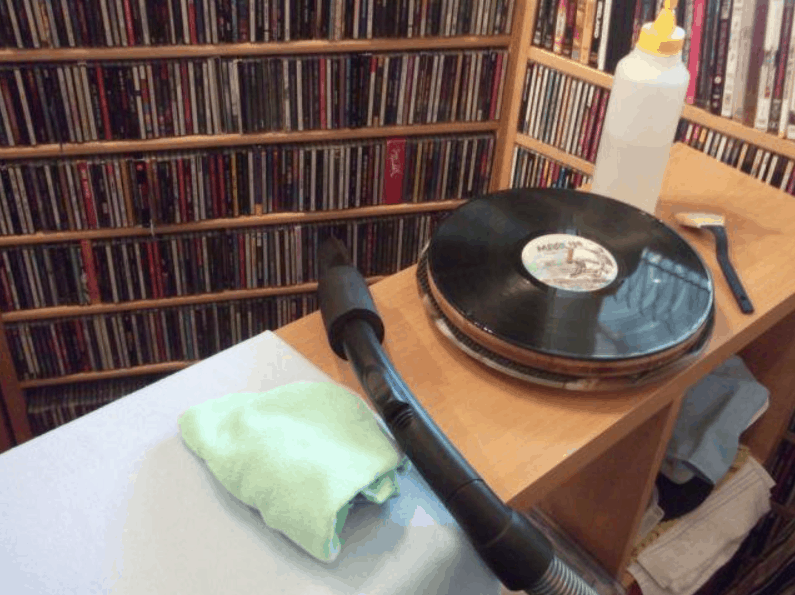
Perhaps you’ve heard people recommending cleaning your vinyl records with a vacuum cleaner. While this is undeniably the best cleaning method, people recommending it are talking about special vinyl record vacuums and not the popular cleaning appliance you’re using to clean the floors.
Vinyl vacuum cleaners are equipped with a special brush and use a suction force that won’t damage the disc.
These vacuum cleaners are fairly expensive, with the price ranging from about $400 to over $1,000. Alternatively, you could invest in a record vacuum attachment that allows you to adapt a standard home vac. However, we wouldn’t recommend cleaning the records with a vacuum that wasn’t built for the purpose.
How to Store and Handle Vinyl Records?
Cleaning vinyl records is only a step for keeping them in good condition. Learning how to store and handle them is also important. Here are a few tips:
- Use a sleeve liner: Vinyl records were originally stored in paper sleeves, but this material can leave residues on the record. To avoid this, place the record in an anti-static sleeve liner before storing it away in its original sleeve.
- Wash your hands: You may not be too worried when handling vinyl records, but the truth is that the oils on your skin can cause fungal growth on records and sleeves. Thus, it is essential to wash your hands each time you want to handle a record.
- Never touch the grooved areas: When handling your records, only touch the edges and label area.
- Store the records in a dry environment: Excessive moisture can cause fungal growth on the record and sleeve. Thus, you should only store the records in a dry place with a relative humidity between 35% and 40%. Generally, the temperature should range between 59°F and 77°F.
- Clean the records each time after playing them: The easiest way to keep your records as new is cleaning them each time after playing. Invest in a good carbon fiber brush and wipe the records clean before storing them away.
Conclusion
Cleaning vinyl records easily and without breaking the bank isn’t complicated. We hope the methods above can help you keep your collection in pristine conditions. That said, we’d love to hear from you. How do you clean, store, and handle your records? Tell us in a comment below, and don’t forget to share this article with your friends.
